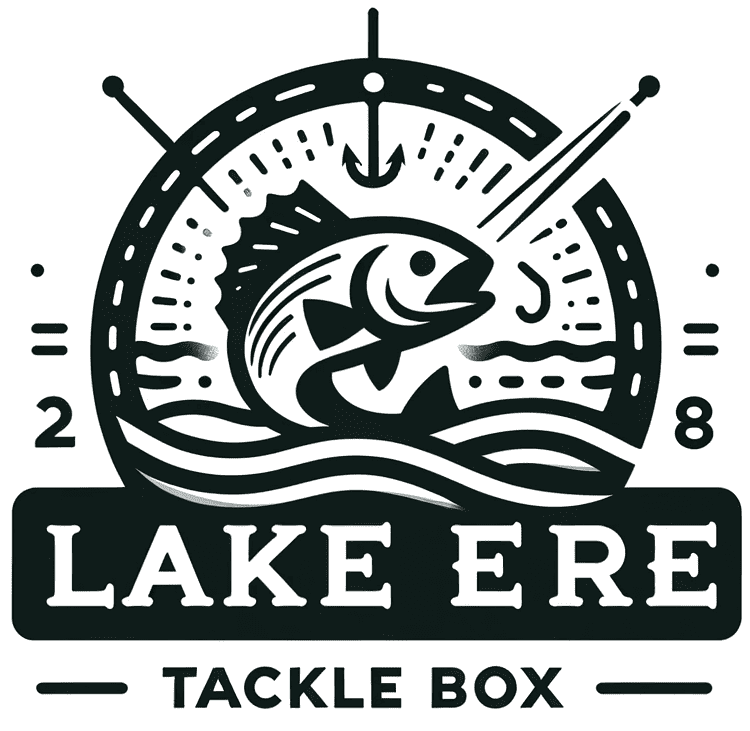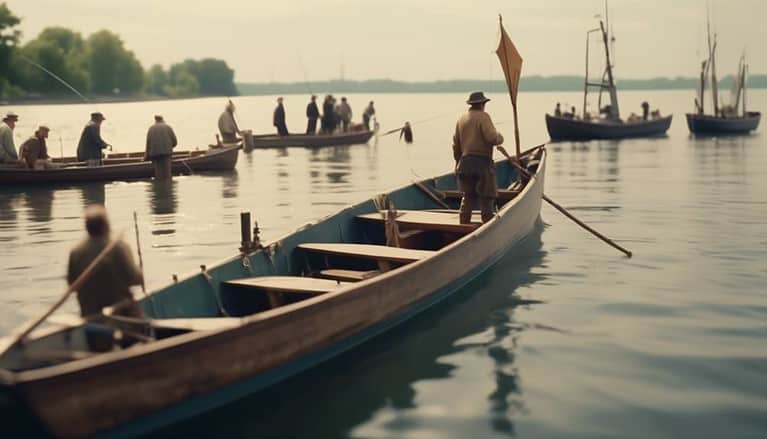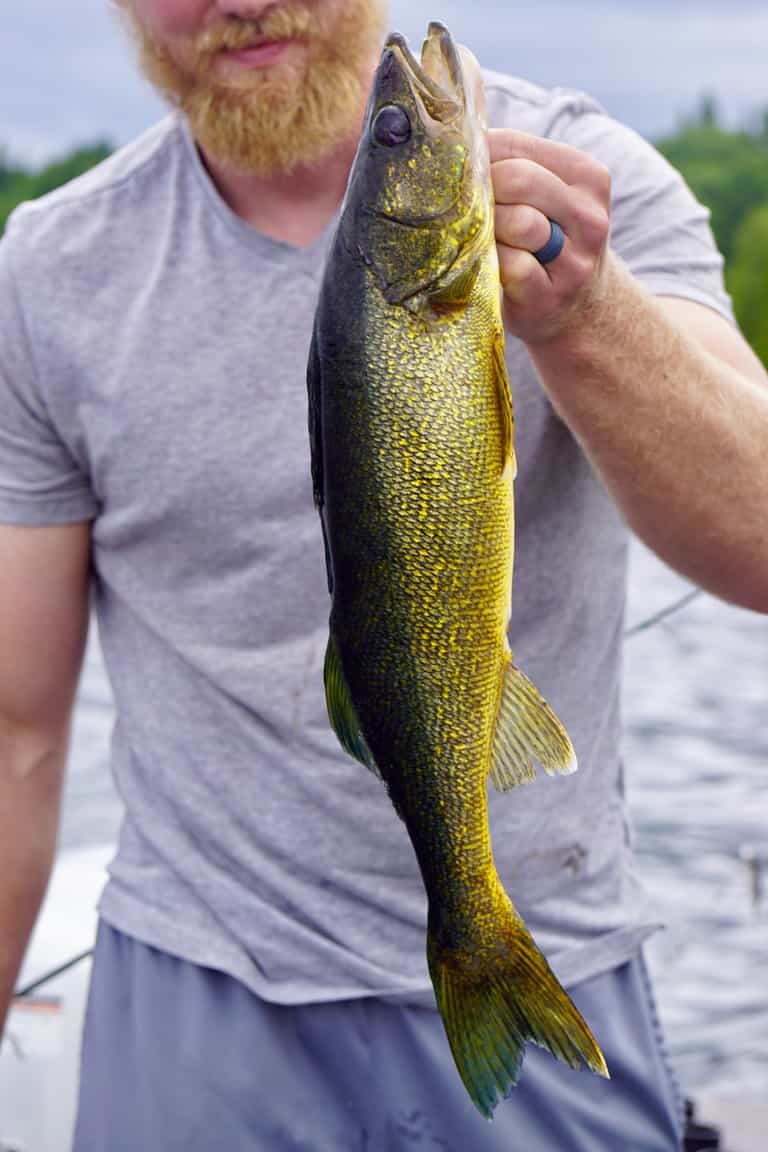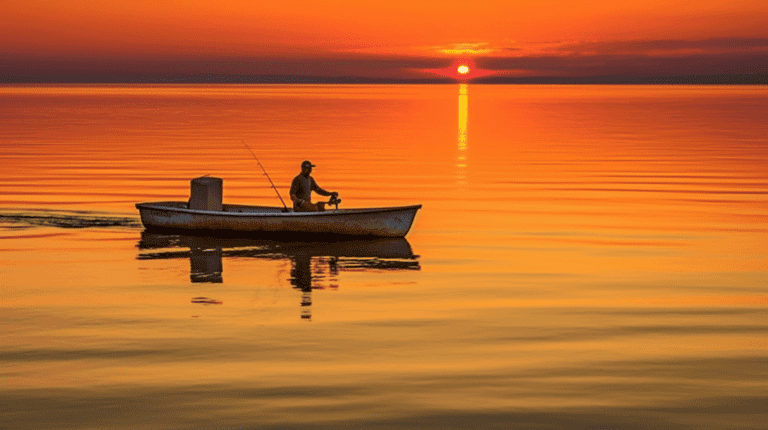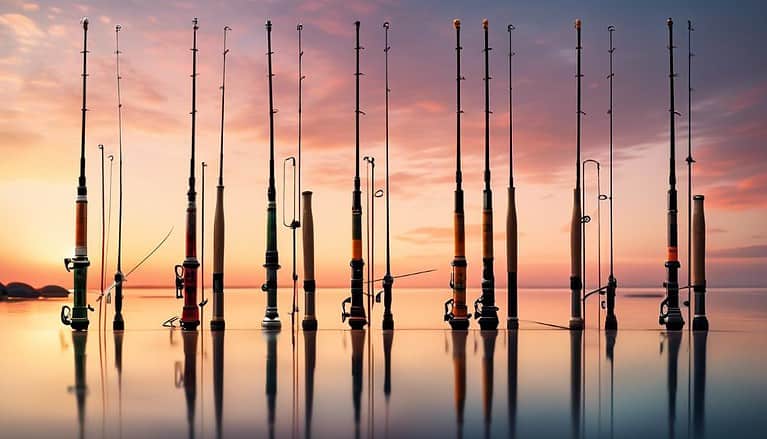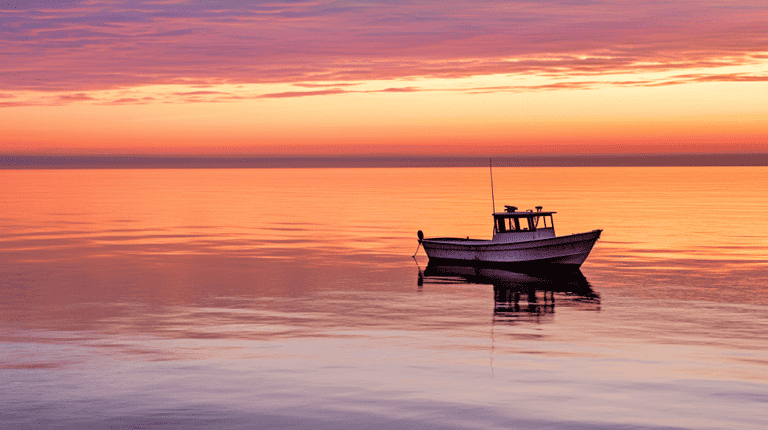15 Essential Tips for Catch-and-Release Fishing in Lake Erie, Ohio
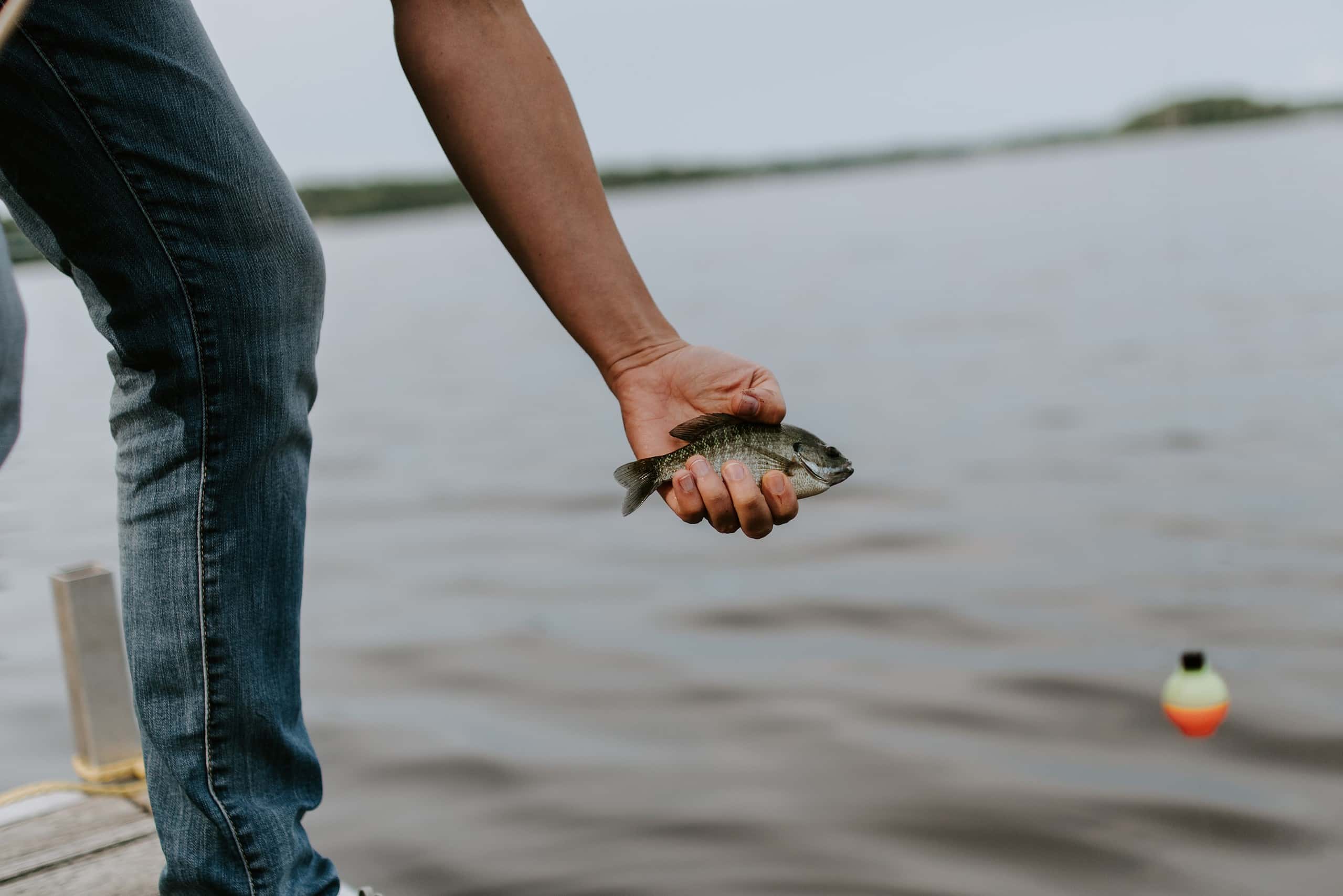
There’s nothing like the thrill of feeling a fish on your line!
But it’s not just about the catch; it’s also about preserving nature’s balance.
You’re about to uncover 15 essential tips for catch-and-release fishing in Lake Erie, Ohio.
You’ll learn to handle your catch properly, master casting, and adapt to unexpected weather.
Ready to enhance your fishing skills while contributing to Lake Erie’s ecosystem?
Let’s dive in!
Table of Contents
Key Takeaways
- Catch-and-release fishing is a conservation-minded practice that aims to reduce the mortality rate of caught fish and contribute to the sustainability of fisheries.
- Understanding the habits and preferences of prominent fish species in Lake Erie is important for successful catch-and-release fishing.
- Choosing the right gear, including rods, reels, fishing lines, hooks, and bait, is crucial for catch-and-release fishing in Lake Erie.
- Proper handling techniques, such as wetting hands before handling fish and safely unhooking fish, are essential for minimizing damage and ensuring the survival of fish in Lake Erie.
Understanding Catch-and-Release Fishing
Before diving into the heart of catch-and-release fishing in Lake Erie, Ohio, it’s crucial for you to understand what this practice is all about. Essentially, catch-and-release is a conservation-minded practice where you, as an angler, reel in a fish, handle it with care, and then release it back into the water.
This practice isn’t just about the thrill of the catch; it’s about preserving the fish populations and contributing to the sustainability of our fisheries. The goal here is to reduce the mortality rate of the fish you catch. It’s all about the right technique: using barbless hooks, wetting your hands before handling the fish to protect its slimy protective coating, and keeping the fish in water as much as possible.
Catch-and-release is a testament to your respect for the aquatic life and your commitment to the environment. It’s not just a practice, it’s a philosophy; one that demands knowledge, patience, and responsibility.
Now that you have a grasp on the essence of catch-and-release fishing, let’s move on to the ideal Lake Erie fish species you should be aiming your hook for.
Ideal Lake Erie Fish Species
Now that you’re familiar with the basics of catch-and-release fishing, let’s delve into the four most common species in Lake Erie that you should focus on for this practice.
Firstly, Walleye is a dominant species in the lake, prized for its size and fighting spirit. You’ll find the Walleye to be a challenging catch that provides a thrilling experience.
Secondly, Yellow Perch, a smaller fish, is abundant in Lake Erie. Their distinctive coloration and aggressive feeding habits make them fun to catch.
Thirdly, Smallmouth Bass are renowned for their fighting prowess. This species is a favorite among anglers due to their tendency to leap from the water when hooked.
Lastly, you can’t overlook the Steelhead Trout. They migrate into Lake Erie’s tributaries, providing excellent fishing opportunities, especially in the colder months.
Each species requires a different approach, so it’s crucial to learn their habits and preferences. This knowledge won’t only increase your success but also ensure a safe release back into the waters.
Now you’re equipped with the knowledge of which fish to aim for, it’s time to turn our attention to the importance of proper fishing gear.
Importance of Proper Fishing Gear
Choosing the right fishing gear is crucial for your catch-and-release fishing success in Lake Erie. It’s not just about having a rod and a reel. You’ve got to consider the type of fish you’re after, the weather conditions, and your personal skill level.
Here are some key gear considerations:
- Rod and Reel: Depending on your targeted species, you’ll need a specific type of rod and reel.
- Bass and Walleye: Medium-heavy rod with a fast action reel.
- Perch and Crappie: Light rod with a slow action reel.
- Fishing Line: The strength and type of fishing line can drastically affect your success rate.
- Monofilament: Great for clarity of water and versatility.
- Braided: Offers high strength and durability.
- Hooks and Bait: The right hook size and bait are vital.
- Circle Hooks: Ideal for catch-and-release due to their design.
- Live Bait: Usually best for enticing fish, though artificial can work too.
Mastering the Art of Casting
You’ve got your gear ready, so it’s time to hone your casting skills to ensure a successful catch-and-release fishing experience in Lake Erie. Mastering the art of casting isn’t just about launching your line as far as possible; it’s about precision, control, and understanding how to adapt to different situations and conditions.
| Casting Technique | When to Use |
|---|---|
| Overhead Cast | Open water, long distances |
| Sidearm Cast | Windy conditions, under low hanging trees |
| Roll Cast | Limited backcast room, heavy lures |
| Flip Cast | Short distances, targeting specific spots |
The overhead cast is your go-to for open water and long distances. Got a breeze or low hanging trees? Try the sidearm cast. If you’re dealing with limited room for backcasting or heavier lures, the roll cast is your friend. And when you need to hit a specific spot at a short distance, flip cast.
Proper Handling of Lake Erie Fish
Let’s now turn our attention to the crucial aspect of properly handling Lake Erie fish.
Wetting your hands before handling, supporting the fish underneath, and avoiding eye contact are key procedures.
These steps are vital in ensuring the survival and wellbeing of the fish after release.
Wet Hands Before Handling
Before handling any fish from Lake Erie, always make sure your hands are wet to minimize damage to their protective scales and slime coating. This simple yet crucial step contributes significantly to the survival of the released fish. Here’s why:
- Wet hands reduce friction, minimizing the removal of the slimy protective layer that’s essential for warding off diseases.
- Dry hands can injure the fish, leading to infections and possibly death.
- Wet gloves can also be used for a secure grip without causing harm.
- Keeping your hands wet ensures a faster return of the fish to its environment, reducing stress and increasing survival chances.
You’ve got the handling right, and now it’s time to delve into how to properly support a fish underneath, crucial for their well-being post-release.
Support Fish Underneath
Often, when you’re holding a fish, it’s crucial to offer full support from underneath to prevent internal injuries. You should cradle the fish horizontally, using both hands if necessary. This protects their organs from undue pressure or potential damage.
Here’s a quick guide on how to properly handle fish:
| DO | DON’T |
|---|---|
| Wet your hands before handling | Lift fish by the gills or eyes |
| Cradle the fish horizontally | Squeeze the fish |
| Handle with gentle, firm grip | Hold fish out of water for long |
| Release the fish quickly | Throw fish back into water |
This care ensures the fish’s survival after release, contributing to a healthy Lake Erie ecosystem. Next, let’s discuss the importance of avoiding fish eye contact to further reduce stress on the fish.
Avoiding Fish Eye Contact
In handling Lake Erie fish, it’s important to avoid direct eye contact to minimize their stress levels. You might wonder how to achieve this while still securing the fish. Here’s how:
- Use a net:
- It’s safer for you and the fish.
- You can control the fish without direct contact.
- Use gloved hands:
- They’ll provide a secure grip.
- You won’t need to look directly into the fish’s eyes.
- Control your gaze:
- Focus on the body, not the eyes.
- Quick glances are less stressful for the fish.
Safely Unhooking a Fish
Now, let’s tackle the art of safely unhooking a fish.
You’ll need to master the proper handling techniques, learn when and how to use specific tools, and understand how to minimize stress for the fish.
Done correctly, it ensures the fish’s survival and maintains the balance of Lake Erie’s ecosystem.
Proper Handling Techniques
When you’ve got a fish on the line, it’s crucial to know how to safely unhook it to ensure its survival post-release. Proper handling techniques are key to this process.
- Keep it in the Water: Minimize air exposure. Fish can’t breathe outside water.
- Don’t lift it by its jaw or gills.
- If necessary, wet your hands before touching the fish.
Use the Right Tools: Having the correct tools on hand can help you remove the hook safely and quickly.
- Use long-nosed pliers or a dehooking tool.
- Cut the line if the hook is too deep.
Revive the Fish: If the fish appears exhausted, hold it upright in the water until it swims off on its own.
- Move it gently back and forth to promote water flow over the gills.
Use of Tools
Having the right tools, like long-nosed pliers or a dehooking device, can make all the difference when it’s time to safely unhook your catch.
With a firm yet gentle grip, use the pliers to remove the hook, minimizing stress and injury to the fish. If the hook’s lodged deep, a dehooking device comes in handy.
Remember, it’s not about brute force; finesse is key. Always work the hook out the way it went in, avoiding excessive twisting or tugging.
If the hook can’t be safely removed, cut the line as close to the hook as possible. The fish’s body will naturally dissolve the hook over time.
These tools aren’t just beneficial; they’re essential for responsible catch-and-release fishing.
Minimizing Fish Stress
While it’s crucial to have the right tools, you must also know how to properly handle and unhook your catch to minimize its stress and maximize its survival chances.
Here are some tips:
- Handle With Care:
- Wet your hands before touching the fish to protect its sensitive scales and skin.
- Keep your fingers away from the gills and eyes.
- Quick Unhooking:
- Use long-nose pliers to quickly and gently remove the hook.
- If the hook is deeply embedded, cut the line as close to the hook as possible.
- Prompt Return:
- Minimize out-of-water time. Aim to return the fish within a few minutes.
- Gently place the fish back in the water, supporting until it swims off.
Practice these techniques to ensure a safe, successful catch-and-release fishing experience.
Reviving a Caught Fish
After you’ve carefully unhooked your catch, it’s crucial to properly revive the fish before returning it to the waters of Lake Erie. The goal is to ensure the fish leaves your care in the best possible condition. Here’s a simple table to guide you:
| Steps to Revive a Fish | Description |
|---|---|
| Hold the fish upright | Support the fish under its belly, keeping it upright in the water. This mimics its natural swimming position. |
| Move the fish back and forth | Gently move the fish back and forth in the water. This helps water flow over the gills, providing much-needed oxygen. |
| Wait for the fish to swim away | Don’t rush this process. Wait until the fish is strong enough to swim away on its own. |
| Use a fish-friendly grip | Avoid squeezing the fish or touching its gills, as this can cause serious injury. |
Best Times for Catch-and-Release
Though you might be eager to hit the waters of Lake Erie at any time, there are certain periods that are more favorable for catch-and-release fishing. Timing is everything when you’re after a successful release.
- Early Morning: Fish are most active at dawn. The cooler air and water temperatures are more comfortable, making them more likely to take the bait.
- Walleye and bass are especially active in the early morning hours.
- Late Afternoon to Dusk: This is another prime time for fishing. As the sun sets and the water cools, fish come closer to the surface to feed.
- Perch and bluegill are more likely to bite during these hours.
- Seasons: Different fish species are more active during different seasons.
- Spring and Fall are the best times for trophy bass.
- Summer is prime time for walleye and perch.
Knowing the best times to fish helps you plan your trip and increases the odds of a successful catch and release. So, plan according to these time frames and seasons, ensuring a thrilling, yet responsible fishing adventure on Lake Erie, Ohio.
Mapping Lake Erie’s Hotspots
You’ve got to zero in on Lake Erie’s hotspots to make the most out of your catch-and-release fishing experience. These are the areas where fish frequently gather, making them ideal for fishing. Knowledge about these hotspots can significantly boost your catch rate.
| Hotspot | Why it’s a Hotspot |
|---|---|
| Western Basin | Noted for its excellent walleye and smallmouth bass fishing. |
| Central Basin | Known for its deep water fishing, especially for steelhead and walleye. |
| Eastern Basin | Famous for its large smallmouth bass and walleye numbers. |
| Islands Area | Particularly rich in perch and smallmouth bass. |
To find these hotspots, you can use a variety of tools. Maps, whether digital or paper, are essential. GPS systems with lake charts can give you an edge. Don’t underestimate the power of local knowledge either. Engage with the local fishing community, as they often have priceless insights about Lake Erie’s hotspots.
Your catch-and-release fishing experience will be much more rewarding if you know where to cast your line. But remember, knowing where to fish is just one part of the equation. Up next, we’ll discuss the importance of adhering to Ohio’s fishing regulations.
Adhering to Ohio’s Fishing Regulations
Every angler must understand that Ohio’s fishing regulations aren’t just guidelines, they’re crucial rules you need to follow for a successful and lawful catch-and-release fishing experience. Adherence to these regulations is fundamental in ensuring the sustainability and preservation of Lake Erie’s vibrant fish population.
Consider the following key areas when you’re out on the waters:
- Fishing Licenses
- You must have a valid Ohio fishing license. Licenses can be purchased online, at wildlife district offices, and at authorized license sales agents.
- There’re different types of licenses depending on your residency status and age. Always ensure you have the right one.
- Catch Limits
- Ohio has specific daily catch limits for different types of fish. Exceeding these limits is against the law.
- Be aware of size limits too. Some fish species must reach a certain length before you can legally catch them.
- Seasons and Times
- Certain fish species can only be fished during specific seasons and times. Ignoring this can lead to hefty fines.
Ethical Fishing Practices
You’re not just fishing for fun, you’re a steward of our waters. Understanding how to properly remove hooks, reduce stress on the fish, and preserve their habitats are key ethical practices you need to adopt.
Let’s explore these aspects to ensure you’re fishing responsibly on Lake Erie.
Responsible Hook Removal
When it comes to ethical fishing practices, a significant part of your job is to ensure you’re removing hooks responsibly to minimize harm to the fish. Here are some key tips:
- Use the correct tools:
- Long-nose pliers for deep hook removal
- Hook cutters for stubborn hooks
- Handle fish with care:
- Get your hands wet before touching the fish
- Support the fish’s weight horizontally
- Avoid unnecessary harm:
- Try not to remove deeply embedded hooks
- Cut the line as close to the hook as possible
These steps, when followed correctly, can help ensure a safe release for the fish. Remember, ethical fishing isn’t just about the catch, but also about the release.
Minimizing Fish Stress
In minimizing your catch’s stress, it’s crucial to understand and implement ethical fishing practices.
- Always wet your hands before handling a fish; this preserves their protective slime coating.
- Avoid dragging fish on dry ground or boat surfaces.
Use barbless hooks or crimp the barbs on your hooks to make removal easier.
- As you reel in, do so quickly but gently.
- Prolonged struggle can exhaust a fish, making survival after release tougher.
Once you’ve landed your catch, avoid keeping it out of water for too long.
- Ideally, unhook and release fish while they’re still submerged.
- If you must lift them, do so horizontally, supporting their weight to prevent internal injury.
Following these guidelines ensures you’re practicing ethical catch-and-release fishing, preserving Lake Erie’s diverse fish population.
Habitat Preservation Importance
Preserving the natural habitat is essential for the thriving fish population in Lake Erie, and it’s something you can contribute to with mindful fishing practices. Ethical fishing isn’t just about the catch-and-release method, it extends to preserving the habitat as well.
Consider adopting these practices:
- Respect the environment:
- Avoid disturbing nesting areas
- Leave no trace, pick up after yourself
- Limit use of motorized boats:
- Excessive use can degrade water quality
- Stick to non-motorized or electric options
- Promote native species:
- Avoid using non-native bait
- Report sightings of invasive species
Beneficial Catch-and-Release Techniques
Often, you’ll find that using the right techniques can significantly increase the survival rate of fish after they’re released back into Lake Erie. It’s just as much about how you handle the fish as it’s about the actual catch.
Firstly, use tackle that’s appropriate for the species you’re targeting. Larger hooks can cause more damage, so use the smallest hook you can get away with.
Secondly, you should aim to bring the fish in as quickly as possible to reduce exhaustion, which can be fatal.
Once you have the fish, avoid handling it excessively or squeezing too tightly. Your hands can remove their protective slime, which leaves them vulnerable to infection. Wet your hands before touching the fish and try to keep it in the water while removing the hook. If the hook is deeply lodged, it’s better to cut the line than to cause further damage.
Remember, the goal isn’t just to catch the fish, but to ensure its survival after release. With these techniques, you’ll become a more responsible angler.
Now, let’s move on to how to handle unexpected weather while fishing on Lake Erie.
Dealing With Unexpected Weather
A significant part of being a responsible angler, beyond using appropriate catch-and-release techniques, is knowing how to handle sudden changes in weather conditions while fishing on Lake Erie. Weather on the lake can shift rapidly, and you need to be prepared.
Here are some tips for dealing with unexpected weather changes:
- Awareness: Always keep an eye on the sky. Changes in cloud formations can signal incoming weather.
- Dark, towering clouds may indicate a storm.
- Cumulus clouds can potentially mean fair weather.
Preparedness: Pack appropriately for your trip.
- Include rain gear, even on sunny days.
- Have a warm jacket handy for sudden temperature drops.
Safety Measures: Create an action plan.
- Know where the nearest shelter is.
- Have a reliable means of communication in case of emergencies.
Preserving Lake Erie’s Ecosystem
Preserving Lake Erie’s ecosystem is a vital aspect of your fishing experience.
Overfishing can disrupt the balance of the ecosystem, wreaking havoc on the lake’s biodiversity.
Adopting sustainable fishing practices ensures the health and longevity of Lake Erie’s marine life and enhances your fishing endeavors.
Importance of Ecosystem Balance
You’re playing a vital part in maintaining the delicate balance of Lake Erie’s ecosystem every time you practice catch-and-release fishing. This practice contributes substantially to:
- Conservation of Fish Population: Catch-and-release ensures the fish population remains stable, preventing species from becoming endangered. This also allows for a continual supply of fish, benefiting both the ecosystem and fishermen.
- Food Chain Maintenance: By releasing fish, you preserve the food chain. This is crucial as every species plays a role in the ecosystem, and its removal can create a negative domino effect.
- Biodiversity: A diverse ecosystem is a healthy one, and catch-and-release fishing helps ensure species diversity. This supports a vibrant, resilient environment.
Next, let’s delve into the serious consequences of overfishing, a threat to Lake Erie’s ecosystem.
Impact of Overfishing
Overfishing, if left unchecked, can devastate Lake Erie’s ecosystem and it’s up to you to help prevent it.
This lake, teeming with diverse species, could suffer a drastic decline if we don’t act responsibly. Overfishing disrupts the delicate balance, leading to a ripple effect that can wipe out native species and promote invasive ones.
It’s not just about the fish; the entire food chain is at stake. You can make a difference by adhering to catch limits and practicing catch-and-release fishing. Using appropriate gear and handling fish gently before release ensures their survival.
Sustainable Fishing Practices
To keep Lake Erie’s ecosystem thriving, it’s crucial that you adopt sustainable fishing practices. It’s not just about catching fish, it’s about preserving the environment for future generations.
Here’s how you do it:
- Practice Catch and Release: This ensures the fish population remains stable.
- Use barbless hooks to minimize injury.
- Handle fish with wet hands to protect their slime coat.
- Follow the Rules: Each state has regulations on fishing to maintain balance in the ecosystem.
- Respect size and bag limits.
- Obey off-limit areas and seasons.
- Leave No Trace: This goes beyond just picking up your trash.
- Don’t disturb the natural habitat.
- Avoid introducing non-native species.
Advancing Your Fishing Skills
While it’s important to understand the basics of catch-and-release fishing, advancing your skills can significantly enhance your experience on Lake Erie. It’s not just about the catch; it’s about the pursuit. Learning to read the water, understanding the behavior of different fish species, and mastering the art of casting can make a world of difference.
Firstly, start by studying the lake’s underwater topography. Lake Erie’s diverse aquatic landscape is home to various fish species, each favoring different water depths and structures. Learning to recognize these can help you predict where the fish might be.
Next, delve into fish behavior. Different species react differently to weather conditions, time of day, and seasons. By understanding these patterns, you’ll know the best times to fish and the most effective baits to use.
Lastly, practice your casting. Accuracy and distance are key in reaching the fish without startling them. Consider enrolling in a casting class or hiring a guide to hone your skills.
Frequently Asked Questions
What Types of Fishing Licenses Are Needed for Lake Erie in Ohio?
You’ll need an Ohio fishing license for Lake Erie. If you’re over 16, a resident license is mandatory. Non-residents require a three-day or annual license. For trout, salmon, or fishing from a boat, additional permits are needed.
Are There Any Specific Health Concerns or Precautions When Fishing in Lake Erie?
Yes, you should be aware of potential health risks when fishing in Lake Erie. Always check the latest advisories about harmful algal blooms and avoid contact with water during these times. Stay safe and enjoy your fishing!
Can Non-Residents Also Practice Catch-And-Release Fishing in Lake Erie, Ohio?
Yes, you can. Non-residents are also permitted to practice catch-and-release fishing in Lake Erie, Ohio. Just ensure you’ve got a valid fishing license and you’re aware of the local regulations. Happy fishing!
What Accommodations or Facilities Are Available Near Lake Erie for Traveling Anglers?
Ever dreamed of a cozy retreat after a long day of angling? You’ll find numerous accommodations near Lake Erie, including campgrounds, bed and breakfasts, hotels, and rental cabins, all within casting distance!
Are There Guided Fishing Tours Available for Novice Catch-And-Release Anglers in Lake Erie, Ohio?
Yes, there are guided fishing tours available for novice catch-and-release anglers in Lake Erie, Ohio. They’ll provide you with all necessary equipment and knowledge to ensure a successful and ethical fishing experience.
Conclusion
So, ready to cast your line in Lake Erie? Remember, it’s about more than just the thrill of the catch. With the right gear, handling practices, and respect for the ecosystem, you can ensure the lake’s fish species thrive.
After all, isn’t preserving Lake Erie’s vibrant ecosystem as rewarding as that moment when the fish bites? Keep honing your skills and enjoy the art of catch-and-release fishing.
